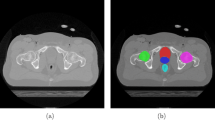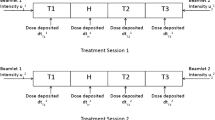Abstract
In intensity-modulated radiotherapy (IMRT), a treatment is designed to deliver high radiation doses to tumors, while avoiding the healthy tissue. Optimization-based treatment planning often produces sharp dose gradients between tumors and healthy tissue. Random shifts during treatment can cause significant differences between the dose in the “optimized” plan and the actual dose delivered to a patient. An IMRT treatment plan is delivered as a series of small daily dosages, or fractions, over a period of time (typically 35 days). It has recently become technically possible to measure variations in patient setup and the delivered doses after each fraction. We develop an optimization framework, which exploits the dynamic nature of radiotherapy and information gathering by adapting the treatment plan in response to temporal variations measured during the treatment course of a individual patient. The resulting (suboptimal) control policies, which re-optimize before each fraction, include two approximate dynamic programming schemes: certainty equivalent control (CEC) and open-loop feedback control (OLFC). Computational experiments show that resulting individualized adaptive radiotherapy plans promise to provide a considerable improvement compared to non-adaptive treatment plans, while remaining computationally feasible to implement.
Similar content being viewed by others
References
Beckham, W., Keall, P., & Siebers, J. (2002). A fluence-convolution method to calculate radiation therapy dose distributions that incorporate random set-up error. Physics in Medicine Biology, 47, 3465–3473.
Bentel, G. C. (1999). Patient positioning and immobilization in radiation oncology. New York: McGraw-Hill.
Bertsekas, D. P. (2005). Dynamic programming and optimal control (Vol. 1, 3 ed.). Belmont: Athena Scientific.
Birge, J. R., & Louveaux, F. (1997). Introduction to stochastic programming. New York: Springer.
Bortfeld, T., & Paganetti, H. (2006). The biologic relevance of daily dose variations in adaptive treatment planning. International Journal of Radiation, Oncology, Biology, Physics, 65, 899–906.
Bortfeld, T., van Herk, M., & Jiang, S. (2002). When should systematic patient positioning errors in radiotherapy be corrected? Physics in Medicine Biology, 47, N297–N302.
Bortfeld, T., Jiang, S., & Rietzel, E. (2004). Effects of motion on the total dose distribution. Seminars in Radiation Oncology, 14, 41–51.
Chetty, I., Rosu, M., Tyagi, N., Marsh, L. H., McShan, D. L., Balter, J. M., Fraass, B. A., & Ten Haken, R. K. (2003). A fluence convolution method to account for respiratory motion in three-dimensional dose calculations for liver: A Monte Carlo study. Medical Physics, 30, 1776–1780.
Choi, B., & Deasy, J. O. (2002). The generalized equivalent uniform dose function as a basis for intensity-modulated treatment planning. Physics in Medicine Biology, 47, 3579–3589.
Chu, M., Zinchenko, Y., Henderson, S. G., & Sharpe, M. B. (2005). Robust optimization for intensity modulated radiation therapy treatment planning under uncertainty. Physics in Medicine Biology, 50, 5463–5477.
Craft, D., Halabi, T., & Bortfeld, T. (2005). Exploration of tradeoffs in intensity-modulated radiotherapy. Physics in Medicine Biology, 50, 5857–5868.
de la Zerda, A., Armbruster, B., & Xing, L. (2007). Formulating adaptive radiation therapy (art) treatment planning into a closed-loop control framework. Physics in Medicine Biology, 52, 4137–4153.
Diwekar, U., Rico-Ramirez, V., Kim, K. J., & Sahin, K. (2002). Optimization under uncertainty. SIAG/OPT Views-and-News, 13(1).
Ferris, M., & Voelker, M. (2004). Fractionation in radiation treatment planning. Mathematical Programming, Ser. B, 101, 387–413.
Herman, M. G., Balter, J. M., Jaffray, D. A., McGee, K. P., Munro, P., Shalev, S., van Herk, M., & Wong, J. W. (2001). Clinical use of electronic portal imaging: Report of AAPM radiation therapy committee task group 58. Medical Physics, 28, 712–737.
ICRU (1993). Prescribing, recording and reporting photon beam therapy ICRU Report 50. Technical Report 50, International Commission on Radiation Units and Measurements (ICRU), Bethesda, MD.
ICRU (1999). Prescribing, recording and reporting photon beam therapy (Supplement to ICRU Report 50). Technical Report 62, International Commission on Radiation Units and Measurements (ICRU), Bethesda, MD.
Keller, H., Ritter, M., & Mackie, T. (2003). Optimal stochastic correction strategies for rigid-body target motion. International Journal of Radiation, Oncology, Biology, Physics, 55, 261–270.
Keller, H., Tome, W., Ritter, M. A., & Mackie, T. R. (2004). Design of adaptive treatment margins for non-negligible measurement uncertainty: application to ultrasound-guided prostate radiation therapy. Physics in Medicine Biology, 49, 69–86.
Kelley, J. E. (1960). The cutting-plane method for solving convex programs. Journal of the Society for Industrial Applied Mathematics, 8, 703–712.
Kessler, M. L., Mcshan, D. L., Epelman, M. A., Vineberg, K. A., Eisbruch, A., Lawrence, T. S., & Fraass, B. A. (2005). Costlets: a generalized approach to cost functions for automated optimization of IMRT treatment plans. Optimization and Engineering, 6, 421–448.
Koshani, R., Balter, J. M., Hayman, J. A., Henning, G. T., & van Herk, M. (2006). Short-term and long-term reproducibility of lung tumor position using active breathing control (ABC). International Journal of Radiation, Oncology, Biology, Physics, 65, 1553–1559.
Küfer, K. A., Scherrer, A., & Monz, M. (2003). Intensity-modulated radiotherapy - a large scale multi-criteria programming problem. OR Spectrum, 25, 223–249.
Lam, K. L., Ten Haken, R. K., Litzenberg, D., Balter, J. M., & Pollock, S. M. (2005). An application of bayesian statistical methods to adaptive radiotherapy. Physics in Medicine Biology, 50, 3849–3858.
Lam, K. L., Balter, J. M., & Ten Haken, R. K. (2007). Effect of daily localization and correction on the setup uncertainty: dependences on the measurement uncertainty, re-positioning uncertainty and action level. Physics in Medicine Biology, 52, 6575–6587.
Lee, E., Fox, T., & Crocker, I. (2003). Integer programming applied to intensity-modulated radiation therapy treatment planning. Annals of Operations Research, 165–181.
Löf, J., Lind, B. K., & Brahme, A. (1995). Optimal radiation beam profiles considering the stochastic process of patient positioning in fractionated radiation therapy. Inverse Problems, 11, 1189–1209.
Lujan, A. E., Ten Haken, R. K., Larsen, E. W., & Balter, J. M. (1999). Quantization of setup uncertainties in 3-D dose calculations. Medical Physics, 26, 2397–2402.
Martinez, A., Yan, D., Lockman, D., Brabbins, D., Kota, K., Sharpe, M., Jaffray, D. A., Vicini, F., & Wong, J. (2000). Improvement in dose escalation using the process of adaptive radiotherapy combined with three-dimensional conformal or intensity-modulated beams for prostate cancer. IntRad, 48, 289–302.
McNutt, T. R., Mackie, T. R., & Paliwal, B. R. (1997). Analysis and convergence of the iterative convolution/superposition dose reconstruction technique for multiple treatment beams and tomotherapy. Medical Physics, 24, 1465–1476.
McShan, D. L., Kessler, M. L., Vineberg, K., & Fraass, B. A. (2006). Inverse plan optimization accounting for random geometric uncertainties with a multiple instance geometry approximation (MIGA). Medical Physics, 33, 1510–1521.
Mestrovic, A., Milette, M., Nichol, A., Clark, B. G., & Otto, K. (2007). Direct aperture optimization for online adaptive radiation therapy. Medical Physics, 34, 1631–1646.
Niemierko, A. (1999). A generalized concept of equivalent uniform dose (EUD) (abstract). Medical Physics, 26, 1100.
Partridge, M., Ebert, M., & Hesse, B. M. (2002). IMRT verification by three-dimensional dose reconstruction from portal beam measurements. Medical Physics, 29, 1847–1858.
Perez, C. A., & Brady, L. W. (1998). Principles and practice of radiotherapy. Philadelphia: Lippincott-Raven.
Petric, M. P., Clark, B. G., & Robar, J. L. (2005). A comparison of two commercial treatment-planning systems to IMRT. Journal of Applied Clinical Medical Physics, 6, 63–80.
Pickle, L. W., Hao, Y., Jemal, A., Zou, Z., Tiwari, R. C., Ward, E., Hachey, M., Howe, H. L., & Feuer, E. J. (2007). A new method of estimating united states and state-level cancer incidence counts for the current calendar year. CA Cancer Journal for Clinicians, 57, 30–42.
Rehbinder, H., Forsgren, C., & Löf, J. (2004). Adaptive radiation therapy for compensation of errors in patient setup and treatment delivery. Medical Physics, 31, 3363–3371.
Romeijn, H. E., Ahuja, R. K., Dempsey, J. F., Kumar, A., & Li, J. G. (2003). A novel linear programming approach to fluence map optimization for intensity modulated radiation therapy treatment planning. Physics in Medicine Biology, 48, 3521–3542.
Ruszczynski, A., & Shapiro, A. (2003). Handbooks in operations research and management science: Stochastic Programming (Vol. 10). Amsterdam: Elsevier.
Schewe, J. E., Balter, J. M., Lam, K. L., & Ten Haken, R. K. (1996). Measurement of patient setup errors using port films and a computer-aided graphical alignment tool. Medical Dosimetry, 21, 97–104.
Schlegel, W., Bortfeld, T., & Grosu, A. L. (2006). New technologies in radiation oncology. Medical radiology / radiation oncology. Berlin: Springer.
Shepard, D. M., Ferris, M. C., Olivera, G. H., & Mackie, T. R. (1999). Optimizing the delivery of radiation therapy to cancer patients. SIAM Review, 41, 721–744.
Sir, M. Y. (2007). Optimization of radiotherapy considering uncertainties caused by daily setup procedures and organ motion. PhD thesis, The University of Michigan, Ann Arbor, MI.
Sir, M. Y., Pollock, S. M., Epelman, M. A., Lam, K. L., & Ten Haken, R. K. (2006). Ideal spatial radiotherapy dose distributions subject to positional uncertainties. Physics in Medicine Biology, 51, 6329–6347.
Stone, H. B., Coleman, C. N., Anscher, M. S., & McBride, W. H. (2003). Effects of radiation on normal tissue: consequences and mechanisms. Lancet Oncology, 4, 529–536.
Thames, H. D., & Hendry, J. H. (1987). Fractionation in radiotherapy. London: Taylor and Francis.
Thieke, C., Bortfeld, T., & Küfer, K. (2002). Characterization of dose distributions through the max and mean dose concept. Acta Oncologica, 41, 158–161.
Thongphiew, D., Chankong, V., Yin, F., & Wu, Q. J. (2008). An online adaptive radiation therapy system for intensity modulated radiation therapy: An application of multi-objective optimization. JIMO, 4, 453–475.
Ulmer, W., & Harder, D. (1995). A triple gaussian pencil beam model for photon beam treatment planning. Zeitschrift Für Medizinische Physik, 5, 25–30.
van Herk, M. (2004). Errors and margins in radiotherapy. Seminars in Radiation Oncology, 14, 52–64.
van Herk, M., Remeijer, P., Rasch, C., & Lebesque, J. V. (2000). The probability of correct target dosage: dose-population histograms for deriving treatment margins in radiotherapy. International Journal of Radiation, Oncology, Biology, Physics, 47, 1121–1135.
Webb, S. (2005). Contemporary IMRT: developing physics and clinical implementation. Bristol and Philadelphia: Institute of Physics Publishing.
Wong, J. W., Sharpe, M. B., Jaffray, D. A., Kini, V. R., Roberson, J. M., Stromberg, J. S., & Martinez, A. (1999). The use of active breathing control (ABC) to reduce margin for breathing motion. International Journal of Radiation, Oncology, Biology, Physics, 44, 911–999.
Wu, C., Jeraj, R., Olivera, G., & Mackie, T. (2002). Re-optimization in adaptive radiotherapy. Physics in Medicine Biology, 47, 3181–3195.
Wu, Q., Liang, J., & Yan, D. (2006). Application of dose compensation in image-guided radiotherapy of prostate cancer. Physics in Medicine Biology, 51, 1405–1419.
Yan, D. (2006). Image-guided/adaptive radiotherapy. In New technologies in radiation oncology. Medical Radiology (pp. 321–336). Berlin: Springer.
Yan, D., Vicini, F., Wong, J., & Martinez, A. (1997a). Adaptive radiation therapy. Physics in Medicine Biology, 42, 123–132.
Yan, D., Wong, J., Vicini, F., Michalski, J., Pan, C., Frazier, A., Horwitz, E., & Martinez, A. (1997b). Adaptive modification of treatment planning to minimize the deleterious effects of treatment setup errors. International Journal of Radiation, Oncology, Biology, Physics, 38, 197–206.
Yan, D., Lockman, D., Brabbins, D., Tyburski, L., & Martinez, A. (2000). An off-line strategy for constructing a patient-specific planning target volume in adaptive treatment process for prostate cancer. International Journal of Radiation, Oncology, Biology, Physics, 48, 289–302.
Author information
Authors and Affiliations
Corresponding author
Rights and permissions
About this article
Cite this article
Sir, M.Y., Epelman, M.A. & Pollock, S.M. Stochastic programming for off-line adaptive radiotherapy. Ann Oper Res 196, 767–797 (2012). https://doi.org/10.1007/s10479-010-0779-x
Published:
Issue Date:
DOI: https://doi.org/10.1007/s10479-010-0779-x




